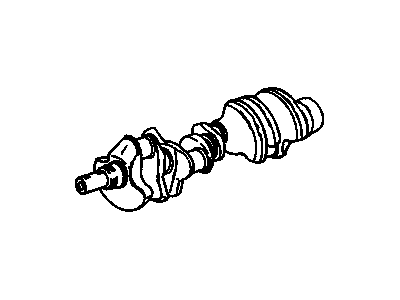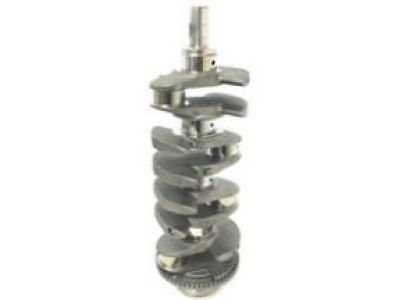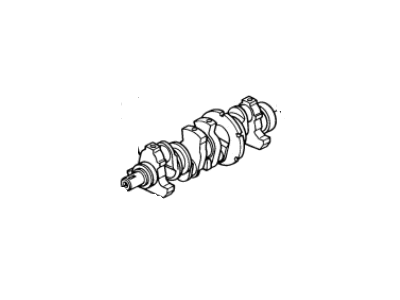My Garage
My Account
Cart
Genuine Chevrolet Beretta Crankshaft
Crank Shaft- Select Vehicle by Model
- Select Vehicle by VIN
Select Vehicle by Model
orMake
Model
Year
Select Vehicle by VIN
For the most accurate results, select vehicle by your VIN (Vehicle Identification Number).
6 Crankshafts found
Chevrolet Beretta Crankshafts
Part Number: 10146900$455.59 MSRP: $723.33You Save: $267.74 (38%)Ships in 1-2 Business Days
Chevrolet Beretta Crankshaft
Each OEM Chevrolet Beretta Crankshaft we offer is competitively priced and comes with the assurance of the manufacturer's warranty for the part. Furthermore, we guarantee the speedy delivery of your orders right to your doorstep. Our hassle-free return policy is also in place for your peace of mind.
Chevrolet Beretta Crankshaft Parts Questions & Experts Answers
- Q: How to install the crankshaft on Chevrolet Beretta?A: Assuming the prior cleaning, inspection, and potential repair or reconditioning of the engine block and crankshaft, the first step in engine reassembly is the installation of the crankshaft. Remove the main bearing cap bolts with the engine positioned bottom-side up and carefully lift out the caps, ensuring their proper order for later installation. If original bearing inserts still remain in place on the block and caps then remove them from there before carefully cleaning lint free cloth. The cleanliness should be maintained at all costs during this process. Those inserts should be cleaned by raking off any build-up on their back surfaces before one insert is placed into each main bearing saddle in this block while another one goes into its corresponding main bearing cap. For correct positioning, make sure that grooved insert is oriented properly in block and tab on bearing insert must align with recess in block or cap. Moreover, oil holes in block have to match those provided for bearing inserts. Depending on the engine type, flanged thrust bearing should be installed at designated cap and saddle location. Additionally, clean faces of bearings in block and crankshaft main bearing journals. Finally, lay it carefully into position in main bearings with taking care to verify cleanliness of crankshaft as well as measure clearance of main bearings oil. For measuring this clearance, Plastigage is used by putting pieces on each crankshaft main bearing journal and installing caps without destroying Plastigage. As always take care not to rotate crankshaft while tightening main bearing cap bolts stages should work from center mains outwardly. When caps are removed compare width of crushed Plastigage with scale provided to determine if it meets specifications for oil clearance of main bearings. If these values are different then some other types of bearings may be needed instead. Clean all traces of Plastigage material from main bearing journals and also their respective faces if need arises again as a part of final crankshaft installation lift out engine followed by cleaning bearing faces in block, applying uniform layer moly-base grease or engine assembly lube on bearing surfaces (including thrust faces) and laying crankshaft back in place. Apply lubricant to the faces of the bearings in the caps and install them in their original locations with the arrows pointing forward. After that, progressively tighten bolts, tapping gently on the ends of crankshaft to align main bearing with crankshaft thrust surfaces. All main bearing cap bolts should be retightened and the crankshaft should be rotated manually to check for any binding. Finally check this by feeling endplay with feeler gauges or dial indicator before installing new rear main oil seal.
- Q: How to remove the crankshaft from an engine on Chevrolet Beretta?A: The crankshaft can only be removed after the engine has been removed from the vehicle. It is assumed that the flywheel or drive plate, crankshaft balancer/vibration damper, timing chain, oil pan, oil pump, and piston/connecting rod assemblies have already been removed. The rear main oil seal/housing (Quad-4 only) must be unbolted and separated from the block before proceeding with crankshaft removal. Before removing the crankshaft, check the endplay. Mount a dial indicator with the stem in line with the crankshaft and just touching one of the crank throws. Push the crankshaft all the way to the rear and zero the dial indicator. Next, pry the crankshaft to the front as far as possible and check the reading on the dial indicator. The distance it moves is the endplay. If it is greater than specified, check the crankshaft thrust surfaces for wear. If no wear is evident, new main bearings should correct the endplay. If a dial indicator is not available, feeler gauges can be used. Gently pry or push the crankshaft all the way to the front of the engine. Slip feeler gauges between the crankshaft and the front face of the thrust main bearing to determine the clearance. Check the main bearing caps to see if they are marked to indicate their locations. They should be numbered consecutively from the front of the engine to the rear. If they are not, mark them with number stamping dies or a center punch. Main bearing caps generally have a cast-in arrow, which points to the front of the engine. Loosen the main bearing cap bolts 1/4-turn at a time until they can be removed by hand. Note if any stud bolts are used and make sure they are returned to their original locations when the crankshaft is reinstalled. Gently tap the caps with a soft-face hammer, then separate them from the engine block. If necessary, use the bolts as levers to remove the caps. Try not to drop the bearing inserts if they come out with the caps. Carefully lift the crankshaft out of the engine. It may be a good idea to have an assistant available since the crankshaft is quite heavy. With the bearing inserts in place in the engine block and main bearing caps, return the caps to their respective locations on the engine block and tighten the bolts finger tight.
- Q: How to inspect and repair a crankshaft on Chevrolet Beretta?A: Use a scraper, stone or file to eliminate all the burrs from the oil holes in the crankshaft; this is equally important; at the same time, chamfering them will remove any sharp edges that might damage new bearings. Examine the main and connecting rod bearing journals for uneven wear, scoring, pits, and cracks. To ascertain its condition, rub a penny across each journal several times-if copper rubs off it and adheres to the crankshaft, the journals require regrinding. If possible, use solvent to clean it before drying it up with clean compressed air. The rest of the crankshaft needs to be magnafluxed for hidden cracks-this should be done by an automotive machine shop. Use a micrometer to measure main and connecting rod journal diameters while taking measurements at different points around each circumference to determine roundness of out of roundness. If damaged, tapered, out-of-round or worn beyond specified limits in specifications given have the automotive machine shop reground your crankshaft.Check both oil seal journals at either end of the crankshaft for wear or damage. In case there are grooves on the journal worn by seal's rubbing or it is nipped/scratched then when again putting back together engine there may be leaking from new seal.Repairing this shaft can sometimes involve pressing on a thin sleeve at an automotive machine shop.If not possible replace with a new or used one replacing.Quad-4 engine builders must inspect their oil pump drive gears for signs of wear or damage.If you need a replacement you will have to bring your crankshaft to a dealer service department or an automotive machine shop.The old gear has been drilled and chiseled off while prior installing into an oven was heated up by another new one.Take time as you also do some examination on inserts for both main and rod bearings.
















